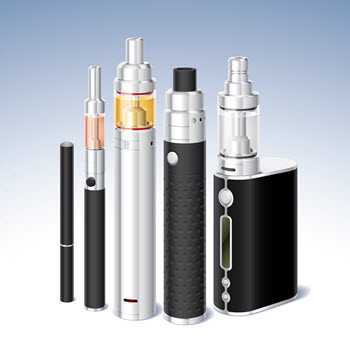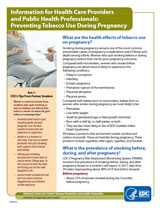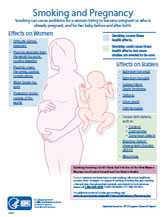For Health Care Providers: Electronic Nicotine Delivery Systems and Pregnancy
What are electronic nicotine delivery systems (ENDS)?
 Electronic nicotine delivery systems (ENDS) are products that typically deliver nicotine and may contain flavorings. ENDS come in different forms, such as e-cigarettes, e-pens, tanks, and mods (i.e., modified by the user). Though some ENDS may be marketed as being nicotine-free, these devices are primarily designed as nicotine delivery systems. Moreover, some ENDS liquids labeled as nicotine free have been found to contain nicotine.
Electronic nicotine delivery systems (ENDS) are products that typically deliver nicotine and may contain flavorings. ENDS come in different forms, such as e-cigarettes, e-pens, tanks, and mods (i.e., modified by the user). Though some ENDS may be marketed as being nicotine-free, these devices are primarily designed as nicotine delivery systems. Moreover, some ENDS liquids labeled as nicotine free have been found to contain nicotine.
What makes up the “vapor” that is produced by ENDS?
ENDS produce an aerosol, that is NOT water vapor. The aerosol may contain nicotine, propylene glycol, glycerin, and flavorings. Some ENDS manufacturers claim that propylene glycol, glycerin, and flavorings are safe because they meet the FDA definition of “generally recognized as safe (GRAS).” However, GRAS status applies to oral ingestion of these ingredients rather than inhalation. The health effects of inhaling these substances are unknown. Additional chemicals that are harmful or may be harmful have been found in some ENDS. These substances include volatile organic compounds, metals, and nitrosamines.
Are ENDS less harmful for pregnant women than regular cigarettes?
ENDS aerosol generally has fewer harmful substances than cigarette smoke. However, ENDS aerosol is not “harmless water vapor” and ENDS and other products containing nicotine should NOT be considered safe to use during pregnancy. Nicotine is a health danger for pregnant women and developing babies and can damage a developing baby’s brain and lungs. Also, some flavorings used in e-cigarettes have been shown to be toxic to human embryonic stem cells.
Can secondhand aerosol from ENDS harm others?
Yes. ENDS aerosol contains nicotine, as well as additional toxins, and is not as safe as clean air. Any released nicotine remains in the atmosphere for a time, where it can be inhaled by others. It can also settle on surfaces to form a residue. Because nicotine can be ingested or readily absorbed through the skin, residue can present a toxic hazard, especially for infants and small children who may come in contact with it. There are no established safe levels of nicotine for children.
What should I tell my pregnant patient who wants to use ENDS to quit smoking?
 Currently, there is not enough evidence to recommend ENDS for tobacco cessation. Also, the FDA has not approved these products for cessation. FDA-approved nicotine replacement treatments (NRT) can be considered when a pregnant woman cannot stop smoking cigarettes on her own or with counseling. NRT use should be closely monitored by a clinician.
Currently, there is not enough evidence to recommend ENDS for tobacco cessation. Also, the FDA has not approved these products for cessation. FDA-approved nicotine replacement treatments (NRT) can be considered when a pregnant woman cannot stop smoking cigarettes on her own or with counseling. NRT use should be closely monitored by a clinician.
What should I tell a postpartum mother who wants to use ENDS as an alternative to returning to smoking?
Currently, there is not enough evidence to support ENDS as effective aids to remaining smoke-free. After a woman’s baby is born, she has more options than when she was pregnant for FDA approved cessation medications. She should be told about the safety concerns related to ENDS use for herself and those around her—including her new baby. Nicotine is very readily absorbed through ingestion, inhalation, skin and mucus membranes, and nicotine is poisonous if the exposure dose is high enough. Parents and caregivers should always store all products containing nicotine, including ENDS and nicotine replacement therapy, out of the reach of children.
Resources
Dual Use of Tobacco Products
Information from CDC’s Office on Smoking and Health.
Tobacco Products
Information from the FDA Center for Tobacco Products.
Smoking Cessation for Pregnancy and Beyond: A Virtual Clinic
This is an interactive web-based program designed for health care professionals to improve their skills in assisting pregnant women to quit smoking. Up to 5.25 hours of continuing education credits can be earned by completing the practicum that was developed by the Interactive Media Laboratory, Dartmouth Medical School in collaboration with the American College of Obstetricians and Gynecologists, the Association of Women’s Health, Obstetric and Neonatal Nurses, and the Centers for Disease Control and Prevention.
- Page last reviewed: July 21, 2016
- Page last updated: July 21, 2016
- Content source:





 ShareCompartir
ShareCompartir